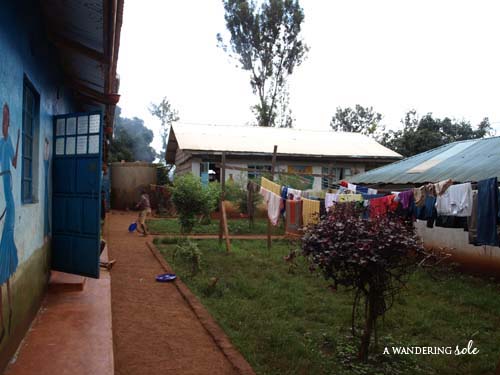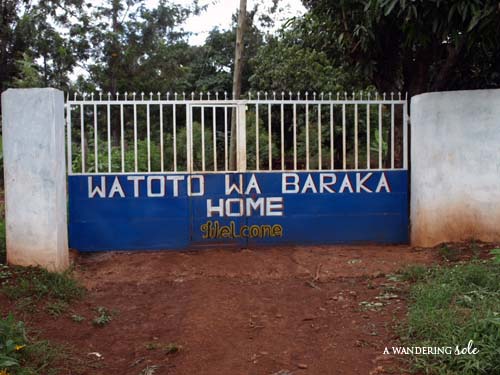Landing in Kenya
You may have read my anticipation, hesitation, and excitement to return to Kenya. After stepping off of the plane, I was the first person in line for a visa. I was told I did not have the right forms filled out and then was corrected about how I filled out the forms. I handed over my $25 (a drop in price since my last visit) and zipped down to baggage. I grabbed my backpack and went to pick up an airport taxi. These taxis are set prices and you don’t have to haggle. It is my understanding that you can walk out of the airport and bargain for your own taxi but the cost savings is relatively insignificant. My plan was to take a taxi into Nairobi and then take a matatu to the village. A matatu probably deserves a post on its own (and it may just happen). It’s a 14-passenger white minibus and is the standard public transport. Yes, you did hear me say 14 as that’s what is ‘official’ but off of the main roads and past police checkpoints you’ll see 20 or more people crammed into these vans. You may have a child in your lap or a bag of maize depending on how full they cram it.
Getting a taxi to Nairobi
Now here’s where memories start to flood back. I approach the taxi desk and tell them, “I need a taxi into Nairobi to go to the matatu station for Pundamilia.” The woman and the man behind the desk both snicker and look at me questioningly. I got the same response every time I was in Nairobi on my last trip. Pundamilia literally means ‘zebra’. Therefore, I’m basically telling them that I need to go to Zebra. No it’s not a pronunciation error people, I did not choose to name the village Zebra, so please stop laughing! They don’t know the village of Pundamilia, and there are lots of matatu stations in Nairobi. I explain to them what towns and villages I pass to get there, and they recognize the town of Thika. Luckily, I have been to Nairobi before and know exactly where the station is downtown so I can direct the taxi driver. The taxi takes me past the Hilton Hotel, and I tell him to go 3 or 4 blocks past it. He nods and says he know which station I’m looking for. We squeeze between buses and finally turn down a side road, where he stops. Umm, no this is not it. I tell the taxi driver it is a big station and emphasize it with hand gestures. Now he’s annoyed with the desk back at the airport because he says that’s the main station, and they didn’t tell him that. But just as we are pulling away, I see matatus on this street, and all of the signs on top of the matatus say ‘Thika’. I tell him to stop, run across the street, and see one that says ‘Thika Kenol Makuya Kamahuha’. That’s it. I approach the front left of the minibus and double-check to see if it’s going to Pundamilia. The man indicates that he doesn’t know. What?? Hello, you’re the driver. Oh wait, the driver sits on the right side of the car in Kenya. Oops. Some conductors (the money collectors) indicate that it’s the right one. I grab my stuff from the taxi and climb aboard for a matatu adventure. We sit there for an hour and a half waiting for it to fill up. The woman next to me is sleeping and there are people coming up to the windows to oogle the ‘mzungu’ (white person).
Matatu Adventure to Pundamilia
When we finally leave, we have to make our way through Nairobi traffic, which is crazy. Combine that with crazy matatu drivers and you just hold on tight and hope for the best. I recognize places as we head north on the main road. We turn off onto a dirt road to make our way to Makuyu, and I start to get excited… only another 15 minutes or so. When we make it to the Pundamilia stage, the conductor unties my bag from the bars behind the driver’s seat, where he tied it earlier to cram more people in, and off I went. I walk down a dirt road and recall that I need to cut across a field on the right. However, since I was last here the grassy field has now been planted with crops. I am a bit turned around for a moment then I find another path and decide that it’s still the same field. Adjusting my luggage, I come to a place where the path splits and see a church. I’m almost to the orphanage! The path opens up, I cross over a dirt road, and up a little hill to Watoto Wa Baraka. The same weathered, handpainted sign was still standing. But I was not prepared for the changes I was about to see.
There was now a second gate in front of the old one and the area was fenced in. What was once a large soccer field was now planted with napier grass (food for the cows). On my last visit there were 2 buildings, 1 cow, 2 pigs, 15 children when I came and 22 when I left, and 4 employees. Now, there are 6 buildings, 3 cows, 22 pigs, 35 children, and 8 employees. I was first greeted by Damaris, who insisted on taking my bags and helping me to my room. A lovely girl, I had actually met her at the orphanage’s first sponsor day in 2008. It was only after she reminded me of this, that I recalled I was the one who took her photo to place in the newsletter requesting sponsorship. It was nice to see that she was now at the orphanage. I was greeted by the children who all seemed to remember me. Some of the ones that were quiet last time had come out of their shell. Those that barely spoke English before were chatting away with me. There were many faces I didn’t recognize and a few I didn’t see. I started to ask, “Where’s Cecilia and Kelvin? Where are Beatrice and Virginia? And Moses?” Some children had gone back with their families. I was or will be able to see all of those kids except for two, whose whereabouts we are not sure of. Those two siblings were special. I was there the day we picked them up to bring them to the orphanage. I cradled Cecilia when she missed her grandmother, and I reassured Kelvin when he cried in the days leading up to my departure.

After expressing my anxieties via e-mail, my mother wrote me that night and told me “You can never go back.” And she’s right. The staff is a completely new set, the volunteer roles are different, and the interaction between staff, children, and volunteers isn’t the same. It’s impossible for an organization to grow and not change, but sometimes those changes are tough to adjust to, even when I know it’s for the better. I was determined to be open-minded but it was initially overwhelming.

Wow, you handled this all so gracefully! I’m very impressed. :)
.-= Andi´s last blog ..imgp2629 =-.
It really must be so hard to go back and see that some kids are gone, and that the experience has to change from what you remember! Sending positive thoughts your way and hoping your settling in well!
Shannon-
It was harder than I thought it would be. I really have been taken aback by the whole experience. But now that I’m getting settled in, it will be time to leave soon! I’m definitely glad I got to come back, see the changes, and visit the children. I’ve learned a lot and even the staff that is here now asks me how it used to be. I had an experience that few people have had or will get- I’ve seen an organization in two different stages of growth. I can pinpoint what I think works and doesn’t work and have a better perspective because of it. Hoping to post more on it soon :)